5 Killer Content Marketing Opportunities I’ll Bet You’re Missing (We Were Too)
Published 2016-11-16, updated 2023-04-26

Summary - Ever feel like your content marketing is as good as it's going to get? We did. Then we were shown what we were missing. Join us for this epic journey.
Ever feel like your content marketing is as good as it's going to get? We did. Then we were shown what we were missing.
Here I’ll tell you the story of how our small digital marketing team went from thinking we were nailing content marketing, to realizing that we were out to lunch and missing some BIG content marketing opportunities, to taking advantage of those opportunities.
And I’ll show you 5 ways we’re now tracking our content marketing to improve our performance.
Frankly, we thought we were hot shit
We were (and remain) a small team of four digital marketers driving more than 100,000 people to our website every month with organic content. We had a content ranking in the top 3 for over 1,300 search queries.

Content marketing plan? Check. Tracking key marketing metrics like reach, engagement, and conversions? Check. We were happy with the results we were seeing, and critically, we were satisfied.

Then we started talking with Andy Crestodina, an SEO and content marketing guru of the first order, though you’ll never hear him admit it.
On a call, Andy took us on a stroll through Google Search Console and showed us a few content optimization tips and techniques he’s picked up over 16 years as a Web strategist, speaker, and writer. Turned out we’d been missing some big opportunities, and Andy’s tour was raising all sorts of questions like:
Are we investing too much energy trying to optimize the wrong content?
Are we wasting high-ranking content?
Who is consuming our content? How? And what are they doing next?
I remember walking off that call with Jon, our Digital Marketing Manager - a longer-than-usual trip down the street to grab a coffee.
We were thinking, our shit’s not hot, and we have a lot of work to do to improve our content marketing.
But we were also feeling energized. We couldn’t wait to jump in.

Andy helped us see that a few adjustments to content and to descriptions of content promised huge gains in traffic, engagement, and leads. And our experience creating custom marketing metrics and dashboards had us excited about tracking these new opportunities in real time.
Here are the top 5 content marketing improvement opportunities we came up with in the weeks that followed. They’re a mix of live reports, metrics, and processes we’ve put in place to continually monitor and improve our content marketing performance.
Top 5 Content Marketing Improvement Opportunities
1
Search Rank Improvement Opportunities
In the past, we were all about new content. We were always looking for opportunities to add new content to our KPI library and our blogs so that we could rank on ever more keywords and queries in our space.
That strategy was working. We were ranking on a growing number of keywords and reaching more of the long tail each week.
But our work was inefficient. We were spending a lot of time writing brand-new content, and not all of it was reaching or engaging the right audience. Sure, some of the new content was ranking highly on the keywords and queries we were targeting. But some of it was ranking poorly (like pages 3, 4, 5, or worse). In fact, some new content was driving zero traffic.
In our heads-down quest to pump out as much new content as we could each week, not only were we often sacrificing quality, but we were missing lower-hanging fruit. The lower-hanging fruit was previously published, moderately performing content. We’ve learned that optimizing this content can provide huge gains in visibility and traffic with low-moderate effort.
Tip: Prioritize optimizing content that is ranking at the top of page two of Google search rankings to get the biggest return on your time investment.
Here’s why: The difference in value between ranking on the first page of organic search results and any page thereafter is huge. Research suggests that only 8.5% of search traffic makes it past the first page. But the effort it takes to push a result up many positions can be high, especially in competitive keyword categories.
Focusing on improving top-of-page-2 content is a quick way to get value from your content optimization efforts. Getting those listings bumped to the first page of organic search rankings will earn the greatest ROI because it takes a lot less effort to move a result from #11 to #10 than to move it to the first page from #15 or #20.
Here’s how:
1. View the average search rank position of your Web content in Google Analytics (Acquisition > Search Console > Queries).
2. Filter the results to display only the listings with an average position of 11 or 12 (Advanced > Add a Metric > Avg Position). This is probably the content that currently sits in the top two positions on page two of the search results.

3. Review the data. You can do so directly in GA or export to Excel. We automated the retrieval of this data in Klipfolio and created this data visualization to give us a quick view of our performance:
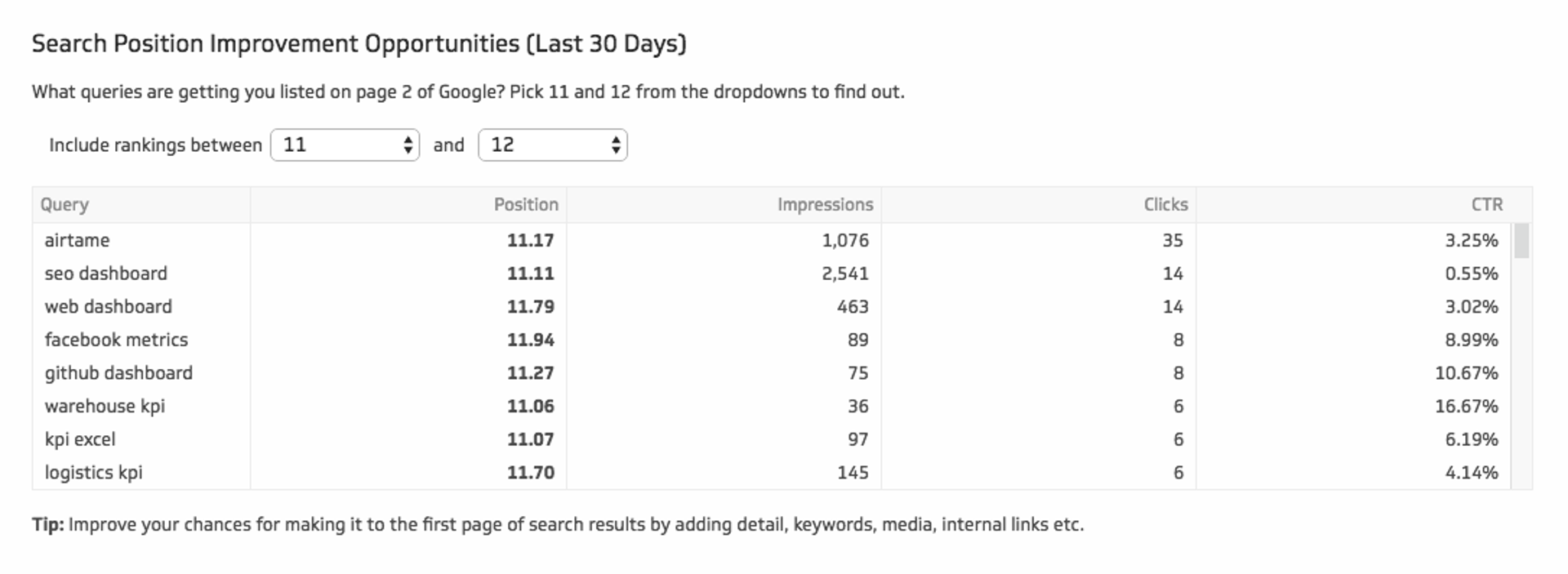
This data visualization helps us prioritize what content improvement opportunities will provide the highest ROI: moving content from page 2 to page 1 of search rankings.
Looking at this visualization, we could quickly see that making small adjustments to certain content could yield huge dividends if we moved that content up even in just one position in search results. In this example, we’d look to improve the content ranking to 11th for “SEO dashboard” and “Facebook metrics” because those queries seem to be somewhat popular (based on the impressions they are receiving at position 11), and we’re seeing a decent CTR.
Next Steps:
Having identified which content you should focus on, how do you optimize it?
- Above all: create content that is useful to the reader. Your content should always address the question, problem, or topic driving the search. In his book CTRL ALT DEL, Mitch Joel writes that we should be proving value before we expect people to drop a single dime. Rather than “hard selling,” it’s helpful to think about content marketing as helping people make informed choices.
- Think about what you want to know when you shop for goods and services. It’s a pretty realistic guide for which questions your content needs to answer. These are questions like ‘What will this cost me?’ ‘What benefits will I actually get from it, and in what timeframe?’ ‘what are the risks?’ ‘how are you better than Competitor X?’
- Incorporate keywords wisely. Ensure that the keyword or phrase you’re targeting is in the title of your content and once in the first sentence. Sprinkle the keyword and related words in H2 headers (for example: if your keyword is ‘ice cream,’ a good H2 might be ‘types of ice cream cones’).
- Keep content lean and rich. Unless they’re essential for basic understanding, avoid using symbols like exclamation marks and dollar signs ($), bolding or italics, or stop words.
Some other rich content tips:
- Make content at least 300 words long because more content generally signals richer content.
- Embed rich content like images and videos because they’re engaging, improve the reader's experience, and receive their own rankings.
- This one’s from Mr. Crestodina himself: include photos of your team members. Doing so not only humanizes your company (always a good idea when marketing to humans), but offers even more ranking opportunities.
- Optimize meta descriptions. Google will bold mentions of a search query in SERPs. An optimized meta description contains the keyword phrase for that bolding goodness; it’s also a compelling summary of why readers should view your content. We offer tips on this subject here: 5 Easy HTML Tags Anyone Can Code and Every Webpage Needs.
- Don’t overlook how internal linking can boost rankings. In this post, Andy outlines how links among pages within your domain can help boost authority for the individual pages, which ups the chance that linked-to pages will rank. Although links to your content from other sites are great for boosting your domain’s overall authority, the beauty of internal links is that they’re all yours to do with what you will—fast and free.
2
Click-Through Rate (CTR) Improvement Opportunities
Back to our power trip.
Months ago, we were feeling pretty good about how our organic content was ranking. We were ranked in the top three for loads of the keywords we were targeting.
But so what? Who cares if your content’s ranking highly if it's not pulling in relevant traffic?
On our little jaunt with Andy, we learned that our number-one ranked blog for a given query was only capturing 10% of all clicks for that query. Ten percent (!)(!!)(!!!). It was click-through Teflon.
That our high-ranking content was crap was a tough pill to swallow, but swallow it we did.
Actually, as we’ve discovered with a bit more research and some therapy, it wasn’t necessarily the content that was crap but the description of the content in the search results.
Tip: Measure the SEO effectiveness of organic content by comparing the click-through rate the content should be receiving (based on its avg search ranking) with the click-through rate it is actually receiving.
Here’s why: According to a CTR study by Advanced Web Ranking, on average, content that is ranked first on an organic search query draws about 30% of all clicks for that query. Content ranked second tends to generate a CTR of about 15%, and third-ranked content usually achieves a CTR of 10%.
This research, which is also supported by a study done by the online ad network Citika, confirms what we all intuitively know: the higher your organic content ranks, the higher your CTR should be. Just as importantly, it gives us content marketing benchmarks to strive for:
| Organic Search Rank | Benchmark CTR |
| 1 | 30% |
| 2 | 15% |
| 3 | 10% |
| 4 | 7% |
| 5 | 5% |
Here’s how:
1. View the average search rank position and CTR of your content in Google Analytics (Acquisition > Search Console > Queries).
2. Export the report to Excel, and add a “Benchmark CTR” column next to the actual CTR stats as reported in GA (write a formula to pull in the correct benchmark CTR based on the average search ranking). Then in a new column, write a formula to find the difference (positive or negative) between the benchmark CTR and the actual CTR. We skipped Excel and created this real-time data visualization in Klipfolio to give us a quick view of our performance:
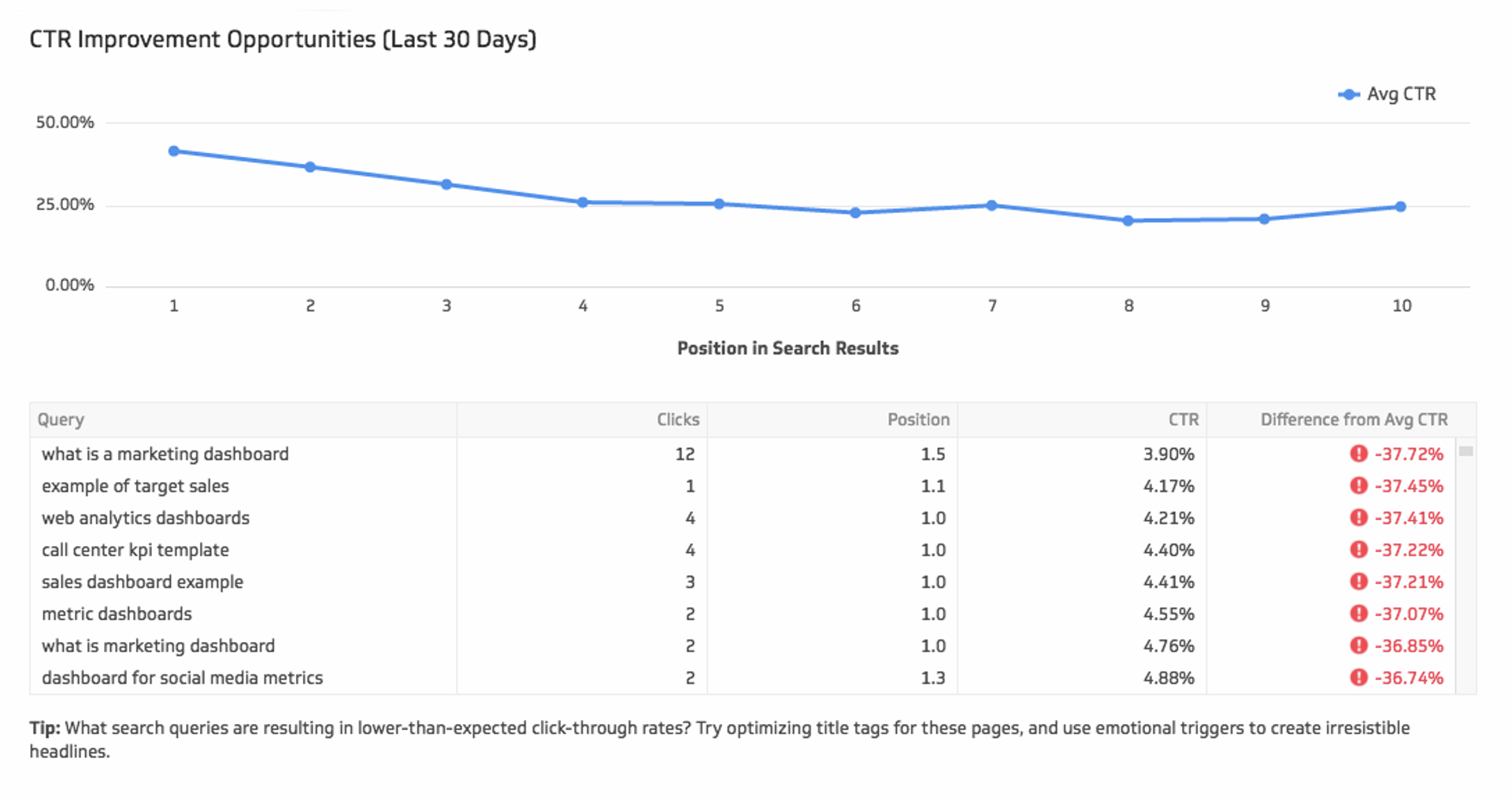
This data visualization gives us quick visibility into how our top-ranked content is performing or underperforming based on actual and benchmark CTRs
Measuring the CTRs of our higher-ranking content against benchmark CTRs, we could quickly see where the biggest opportunities to improve were. Improving the CTRs on these high-ranking queries would vastly improve the flow of traffic to our site.
Next Steps:
If your CTR is underperforming relative to your search rank position, there are two things you can immediately adjust: the title of the content and the meta description.
Here are some do’s and don’ts from Andy Crestodina on how to optimize those:
Do:
- Know the right words to use with each type of user. Check out Andy’s blog 131 Words That Increase Web Traffic, for a list of words that attract buyers, encourage hovering fingers to click, and make people want to share.
- Add numbers to your title tag.
- Add an adjective with emotion (sometimes bad emotions work too - see Crestodina’s 131 Words post linked just above^^).
- Add a specific benefit to the title. Instead of “Home Page Title Tag Best Practices,” try something like “9 Killer Home Page Title Tag Tricks for Higher CTR”.
Don't
- Remove the target keyphrase (or you might hurt your ranking).
- Write a title tag longer than 55 characters (or it will get truncated).
3
Top Posts by Page Views and Conversion Rate
Another mistake we used to make with a lot of our content, and especially our high-traffic, top-of-the-funnel content, is that we’d make the wrong ask(s) or we’d make no ask at all.
To exemplify our first mistake, we’d drive a lot of traffic to a blog post like Best Practices For Picking The Right KPIs For Your Business, which appeals to a wide segment of our target audience, and then embed a variety of product CTAs (Calls To Action) in the post like “Add This Data Visualization to Your Dashboard” or “Start Your Free Trial.”
These CTAs disrupted the natural flow of information in the post, which reduced engagement (average time on page and scroll depth). And because a large majority of the visitors to the post had little to no knowledge of our company, product, or value proposition, the CTAs were completely ineffective (click-through rates were abysmal).
The disruptive CTAs also broke the bit of trust that web visitors had invested in us when they clicked the blog title in the SERP, so a lot of them bounced, never to be seen by us again.
A second mistake we used to make was in producing a whole bunch of top-of-the-funnel content with no direct CTAs of any kind. We’d publish content defining various metrics and KPIs relevant to our target audiences and hope visitors clicked links to middle-of-the-funnel content that we placed in and around the post.
Most read what they wanted, took what they wanted, and left, and we didn’t know who they were or how we could reach them.
These mistakes cost us, especially when we had really high traffic generating content that wasn’t generating any leads. But we’ve learned from the experience and from content marketing experts to do the following:
Tips: Pair content at different levels of the marketing funnel with CTAs that fit the stage of the buyer journey your audience is in.
Tips: Link top-of-the-funnel traffic-generating content with bottom-of-the-funnel purchase-generating content to enhance conversion rates and volume.
Here’s why: If you’re attracting visitors to pages from which people tend to flee, what’s the value of drawing them there in the first place? As Andy Crestodina says, “It’s like constantly refilling a leaky bucket instead of just fixing the leak.”
At the same time, and as suggested above, many viewers of your top-of-the-funnel content will know next to nothing about your company or your product. This is likely their first time on your site. They may not even know they have the pain or desire you’re trying to tap into. They’re in discovery mode.
That said, trying to sell them something at this early stage of their buying journey will not be effective. In fact, as content marketing expert Barry Feldman notes, “Only 2% of first-time website visitors make purchases—and that applies to carefully crafted websites optimized for conversion.”
It’s all about context, says James Ellis, VP of Inbound Marketing at TMP Worldwide. “Everyone thinks the problem is the quality of content. It's not. It's usually more about context. Offering pizza to someone who isn't hungry won't get you many pizza sales.” More on James's perspective on effective content marketing is here.
So think about your audience and their motivation for visiting your top-of-funnel content, and don’t try to serve up bottom-of-the-funnel CTAs before your audience is motivated to consume them.
Instead, work to drive to complementary content that’s a bit further down the funnel, making relevant offers along the way (as we’ll discuss below). Then, once you’ve won the trust and consideration of your target audience, you can start to weave your solution and your product into the content and make your ultimate ask.
Building your content funnel to work like a funnel is the key to driving high-volume, highly qualified leads down to purchase. To do this well, you have to know what your highest traffic-generating content is and what content is producing the most product-related conversions (demo sign-up, trial start, purchase, etc.), so you can sync them up.
If you’re like us and have a lot of content out there already, here’s how to get your head around an effective internal linking strategy.
Here’s how:
1. View page views and conversion rates in Google Analytics (Behaviour >Behaviour Flow > Site Content > Content Drill Down).
2. Evaluate the data. What content is receiving the highest pageviews? What content is producing the most product-related conversions (demo sign-up, trial start, purchase, etc.)? We created the interactive data visualization below so we don’t have to go fishing for answers in GA. This example uses Subscriptions as the conversion metric we’re watching, but you can use any goal you’ve set up in GA.
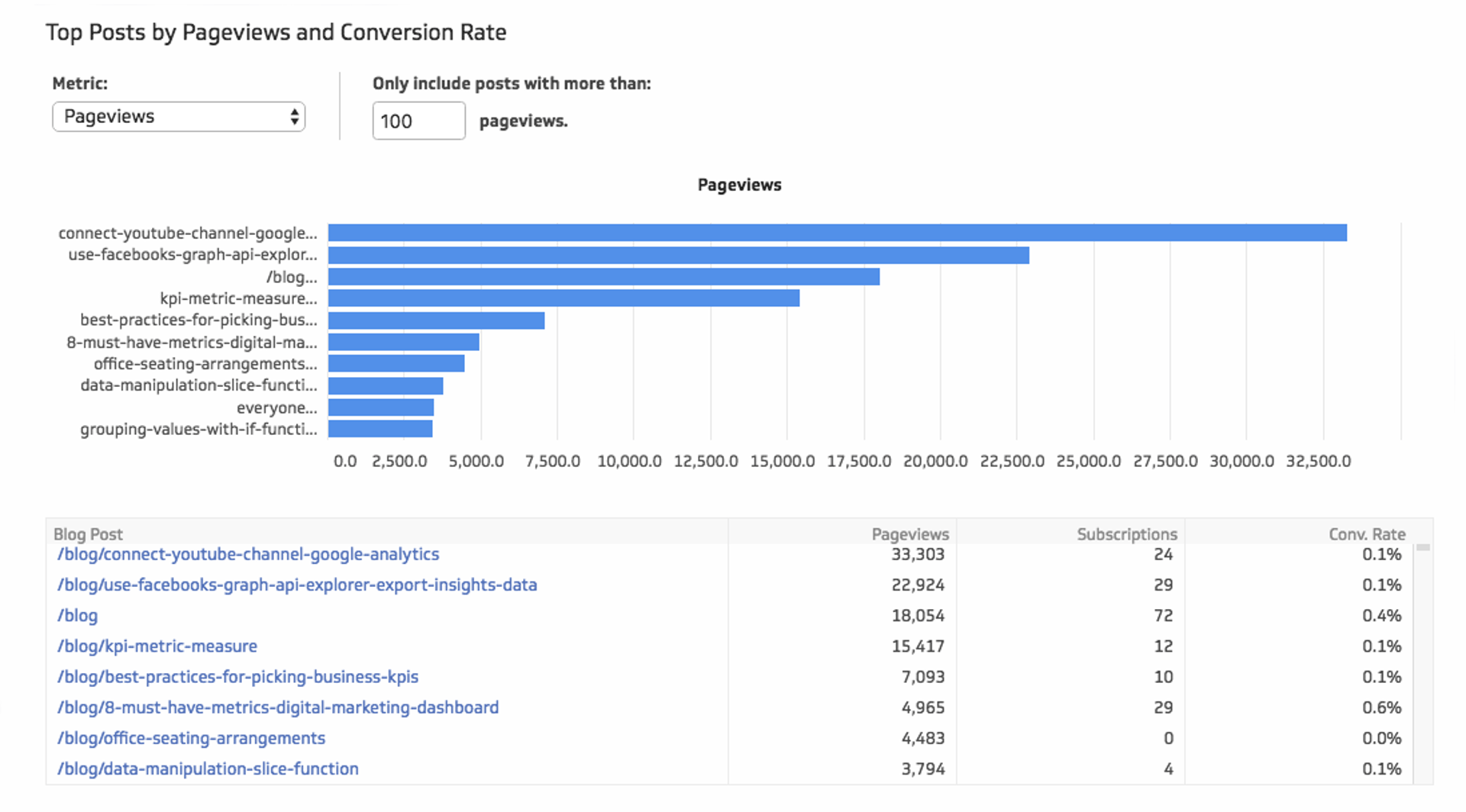
This data visualization enables us to quickly toggle between top-performing content by page views and conversions, so we can think through a logical linking strategy.
Next Steps:
Once you’ve identified your top traffic-driving content and your top conversion-driving content, you can start to think through a logical linking strategy to take viewers further down your marketing funnel.
- First, re-evaluate your high-traffic content. Assuming it’s top-of-the-funnel content, strip it of CTAs related to your product or service.
- Consider adding relevant offers to your traffic-generating content - what Barry Feldman calls “lead magnets.”
- In Barry’s words, “Lead magnets are free offers you make in exchange for an email address (and possibly additional information).” Free offers might include an ebook, a video, an infographic, etc. What makes an offer “magnetic” is relevance, specificity, authority, value, and the promise of instant gratification, Feldman says.
- Next, take stock of what complimentary, closer to your value-prop content you can link to. This should be content that overlaps a sub-topic, theme, or argument made in the top-of-the-funnel content piece and touches on the value proposition of your product/service. You should have several secondary pieces of content that fit this bill, catering to slightly different user segments.
- For example, if you’re selling accounting software and you’ve published a top-of-the-funnel article like “Study Tips For The CPA Exam,” secondary content that you could link to within that article might include “Accounting Tips for Tech Startups” and “Cloud Accounting Security Considerations for Enterprises.” These secondary pieces of content will help you qualify and segment leads, so you can serve up more targeted and more effective content further down the funnel and, ultimately, convert more leads to customers.
4
Behavior Flow & Flow Through Rate
As we took a harder look at our top traffic-generating content and our top converting content, we started thinking more about the journeys people were taking through our content and our website.
How many pages were people exploring after that initial content experience?
What path were people taking through our content?
Were people diving deeper into our site and our product with each successive piece of content they consumed? Or were they just skimming the top-of-the-funnel content and then leaving?
We wanted to find out.
Tip: Track where users go after they’ve consumed an initial piece of content on your site to learn more about them and the effectiveness of the buyer journey’s you’ve mapped out.
Here’s why: understanding what visitors are doing after their first content interaction will tell you more about who they are, which will help you serve up more relevant content to drive deeper engagement. It can also alert you to a misstep in your audience targeting - if you’ve published content that you think should resonate with your target audience, but your bounce rate is high, maybe the description of your content in search results is misleading and attracting the wrong audience.
Tracking what visitors are doing after their first content interaction should also give you a read on how well your content format/layout, internal linking strategy, and site navigation are working. If it's working well, engagement and conversions should be up.
Here’s how: Google Analytics’ Behaviour Flow Report can help you understand the path that users travel through your content and, more specifically, how effective your top-of-the-funnel, high-traffic content is in attracting the right audience and drawing users deeper into your site.
1. Access the Behaviour Flow Report in GA (Behaviour Flow>Pages and Events).
2. In the second drop-down list, next to ‘Pages and Events,’ select the Web page you’d like the report on.
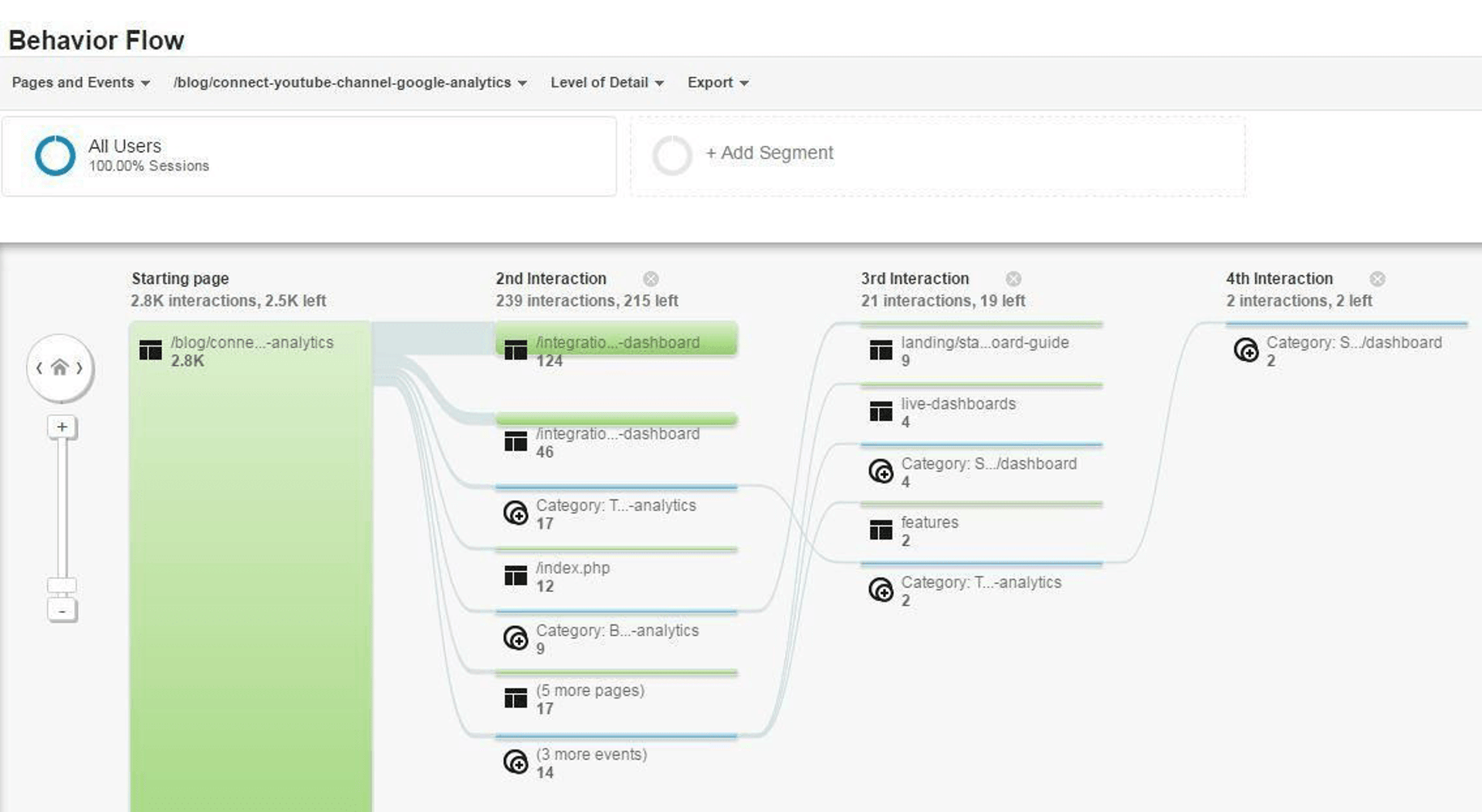
3. Review the data. While this GA report gives us a lot of useful information, it’s not readily accessible in GA, and it’s not the most intuitive visualization. We built out this data visualization to help us get actionable information faster.

This data visualization shows us what top-of-funnel content is driving the deepest engagement with our site based on how many internal pages are viewed after the first page is visited.
A low “Avg # of interactions” (highlighted in red) tells us where users are checking in and then checking right out again. These are clearly points we need to address. It also points out what content (highlighted in green) is driving engagement.
Next Steps:
If only a small fraction of users are exploring your site, or hordes are fleeing after the first-page view, then take a closer look at the following:
- Internal links. I talked about them above. Not only are internal links an easy and inexpensive way to boost page rankings, but they’re critical to the user journey. Are you using internal links frequently and appropriately within your content, offering users links to related information when and where they’re most likely to want it?
- Audience. Is your top-of-funnel content attracting the right audience for your middle and bottom-funnel content? You can learn more about what types of people are viewing your content either by (a) setting up an audience segment in GA and viewing the website traffic/stats through that lens or (b) using GA's advance API Explorer to pull out specific audience data relating to specific content on your site.
- Content quality. Is your content well-written and engaging? Consider your content from the reader’s point of view: is it clear and concise? Is there a compelling story? Ann Handley offers a lot of advice on writing quality content, and here are a few tools to help you evaluate and improve readability: the Hemingway App, and Grammarly.com.
Don’t forget the value of visual communications as part of the overall reading experience, either.
- Overall site navigation. Is your site navigation clear and succinct? Here are some best practices and common mistakes.
5
Scroll Depth
Another question that soon came up in our disrupted state of satisfaction with our content marketing was:
How are people interacting with our content?
Are they reading it? Skimming it? Opening it only to leave it to collect dust on a shelf of forlorn browser tabs?
We were already using standard page tags in GA to get a bunch of useful content metrics like bounce rate, page views, and time on the page. But reading Rob Flaherty, Simo Ahava, and Justin Cutroni, we knew we could learn even more about what our visitors are doing by setting up scroll depth as a custom event in GA.
Knowing how much of the page visitors are viewing might seem like a ‘nice-to-know.’ But as Rob Flaherty points out (he developed the Scroll Depth plug-in we point you to below), the true magic happens when you correlate this insight with other metrics.
Which areas of your site tend to be read more thoroughly?
What’s different about how certain types of visitors (first-time, repeat) explore?
Where do these different readers tend to come from?
Before we looked at scroll depth, we didn’t really know.
Now these combined metrics are giving us important clues for optimizing content topics and length, navigation, linking, and more.
Tip: Set up and track scroll depth as a custom GA event so you can see who’s reading your content and whose skimming it, and who's skipping it.
Here’s why: knowing if and how people are consuming your content will help you create the right content for the right people, to drive specific goals.
Maybe your long-form content is driving traffic, but it's not being read: s it worth the time to write more long-form content?
Maybe people are visiting your content for a specific snippet of information, and they’re jumping to the middle of the page to get it: should you move it to the bottom?
Are readers more likely than skimmers to jump to a second or third piece of content on your site? What segments are more likely to convert?
1. You can build a custom event to track scroll depth in GA yourself or use Rob Flaherty’s handy plug-in: https://scrolldepth.parsnip.io/.. The plug-in helps you monitor scroll points at 25%, 50%, 75%, and 100% and also recognizes a baseline event. You can trigger custom events to track when elements of the page—videos, visuals, sections, etc.—scroll into view.

Source: medium.com/google-analytics/hacking-google-analytics-24762924fbf8#.mbdpu0y73
Next Steps:
So what do you do if you find that users are not traveling down your page?
- Compartmentalize. As with any kind of consumption, digesting information is easier when you break it up into smaller, bite-sized pieces—especially when it’s being read on a screen. Most experts agree that online paragraphs should be very short (ideally no more than 3 sentences) and that tools like bullets and other visual elements help people scan and remember.
- Show and tell. Graphics and rich content like video are not just desirable but essential. They offer an opportunity to differentiate, personalize, and memorialize your content in a way that is easy for users to take in.
- Consider the position of visual elements. A best practice of Crestodinas is to always have at least a piece of an image in front of the user at all times.
- Tease out the point. Are you willing to invest the time reading something if it doesn’t offer you value? Your readers aren’t either. Don’t save your best point for last—hint at it early on and build up to it throughout the page.
We weren’t ‘all that and we still aren’t
Our talk with Andy Crestodina was an eye-opener. We’d been blindly barrelling down the well-worn Content Marketing Expressway, but he inspired us to take in a few smart side trips along the way. And we started asking more and deeper questions about our content marketing.
We’ve come a long way, and we’re going strong, but we’re no longer satisfied with the status quo, and that is our status quo.
Do you have uncommon content marketing insights to share? How do you use less-common metrics to keep your content optimized? We’d love to hear from you in the comments below.
P.S.
Want to see how we built the metrics and data visualizations featured in this blog? Check out this article: 4 Content Marketing Metrics You Should Be Watching Carefully - Here’s How
Quick List: External links used in this post
- 24 experts list their must-watch content marketing metrics in this slide show.
- InFront’s detailed SEO research, including the finding that only 8.5% of search traffic makes it past the first SERP
- Mitch Joel’s blog
- Mitch Joel’s book, CTRL ALT DEL,
- LinkedIn’s this great content marketing eBook
- Comprehensive multilingual list of stop words
- Andy Crestodina, the SEO expert, thought leader, speaker, Most Popular Speaker at CM World, and Founder of Orbit Media Studios
- …on content to include on your site
- …on how to get the most from internal linking
- …on 131 Words That Increase Web Traffic
- …on how to optimize content for lead generation
- CTR study by Advanced Web Ranking
- Content marketing expert Barry Feldman
- Content marketing expert James Ellis
- Writing and content expert Ann Handley
- Readability and grammar tool the Hemingway App
- Grammar checker Grammarly.com
Related Articles

Top Six Data and Analytics Trends – 2024
By Allan Wille, Co-Founder — December 11th, 2023

Maximizing Business Insights: The Power of dbt’s Semantic Layer with Klipfolio PowerMetrics
By Jeroen Visser — November 27th, 2023
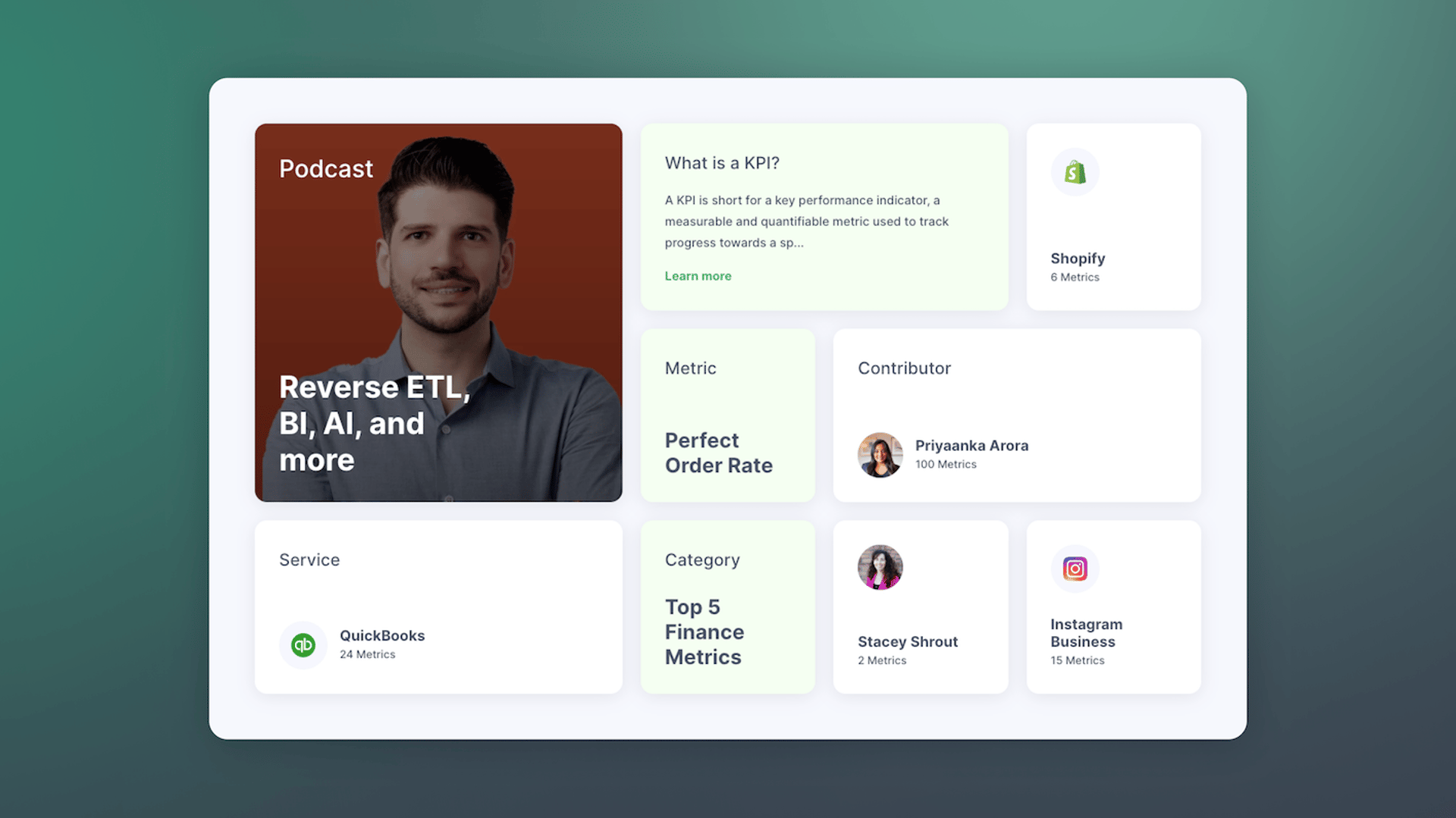
Promoting data literacy with metrichq.org and the power of AI
By Allan Wille, Co-Founder — October 12th, 2023

Let’s fix analytics so we can stop asking you for dashboards
By Cathrin Schneider — September 11th, 2023
